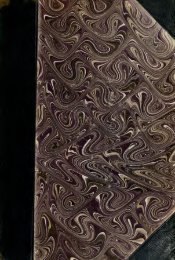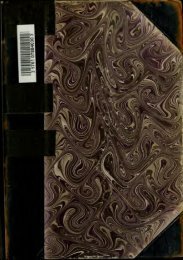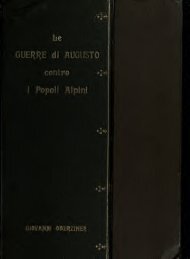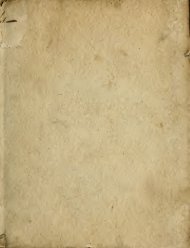Figurative uses of animal names in Latin and their ... - mura di tutti
Figurative uses of animal names in Latin and their ... - mura di tutti
Figurative uses of animal names in Latin and their ... - mura di tutti
You also want an ePaper? Increase the reach of your titles
YUMPU automatically turns print PDFs into web optimized ePapers that Google loves.
23<br />
^eX&vai eXa^paC ' light tortoises/ which, he says, were con-<br />
structed with the express purpose ( iva ) <strong>of</strong> hav<strong>in</strong>g <strong>their</strong><br />
shape like that <strong>of</strong> the tortoise : '^O^vovrai Se aviaov'^ek oi<br />
jcdfjLaKei irap eva "va to vtt' air&v (ry(i]fia -g yeXmvr].^'^^<br />
Varro likewise assigns the figurative use to a likeness <strong>in</strong><br />
external appearance, as the connection <strong>in</strong><strong>di</strong>cates (see quo-<br />
tation p. 39).<br />
We may conclude, then, that orig<strong>in</strong>ally a device was<br />
needed to ward <strong>of</strong>f weapons. The most effective contrivance<br />
happened to be convex, the shape <strong>of</strong> the tortoise.<br />
From this resemblance came the transferred use <strong>of</strong> the<br />
term testudo}'^^<br />
Accord<strong>in</strong>g to Isidore, the term testudo is likewise applied<br />
to an <strong>in</strong><strong>di</strong>vidual shield: Dicitur autem et testudo scutum.<br />
Nam <strong>in</strong> modum testud<strong>in</strong>is fit clypeus.^"'''<br />
The name testudo is itself due to the resemblance between<br />
the testae <strong>of</strong> the vaulted ro<strong>of</strong> to the segments <strong>of</strong> the<br />
curv<strong>in</strong>g shell: Testudo <strong>di</strong>ctus, eo quod tegm<strong>in</strong>e testae sit<br />
adopertus <strong>in</strong> camerae modum.^"*<br />
Fancy is given free re<strong>in</strong> <strong>in</strong> Martial's testudo^°^ for the<br />
hedgehog's ball <strong>of</strong> sp<strong>in</strong>es <strong>and</strong> <strong>in</strong> Ovid's use <strong>of</strong> the term^^"<br />
for an ornamental head-dress.<br />
In post-classical Lat<strong>in</strong>, cancer, ' crab,' <strong>and</strong> cattus, ' cat,'<br />
partly <strong>di</strong>splaced the term testudo:<br />
Expugnavit Rex hanc civitatem per duo vasa (<strong>in</strong>strumenta)<br />
concava, quae faciebant artifices sapientes. Unum<br />
vas Cattus vocabatur, aliud Cancer. Erant haec vasa longa,<br />
quadrata, ex omni parte laterum clausa :<br />
versus terram nul-<br />
lum munimen habebant, sed versus caelum de tabulis forti-<br />
bus ac spissis tectum, mach<strong>in</strong>arum lapides m<strong>in</strong>ime metuebat,<br />
etc.<br />
•" Math. Vett. p. 15.<br />
"° In vol. I, p. 244, <strong>of</strong> his revision <strong>of</strong> J. G. Wilk<strong>in</strong>son's The Ancient<br />
Egyptians, S. Birch has expressed the op<strong>in</strong>ion that the trypanon or pike <strong>of</strong><br />
the testudo arietaria <strong>of</strong> the Greeks <strong>and</strong> Romans, <strong>and</strong> the cover<strong>in</strong>g or v<strong>in</strong>ea<br />
which protected the men while they worked the batter<strong>in</strong>g-ram, were most<br />
probably borrowed orig<strong>in</strong>ally by the Greeks from Egypt.<br />
*"Isid. Orig. xviii, 12, 6.<br />
"' Isid. Orig. xii, 6, 56.<br />
""Mart, xiii, 86, i.<br />
""Ov. Ars iii, 147.


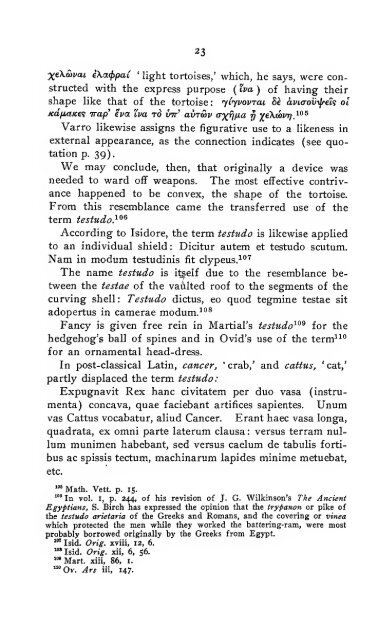
![Das Kriegswesen der Alten [microform] - mura di tutti](https://img.yumpu.com/21606999/1/167x260/das-kriegswesen-der-alten-microform-mura-di-tutti.jpg?quality=85)


